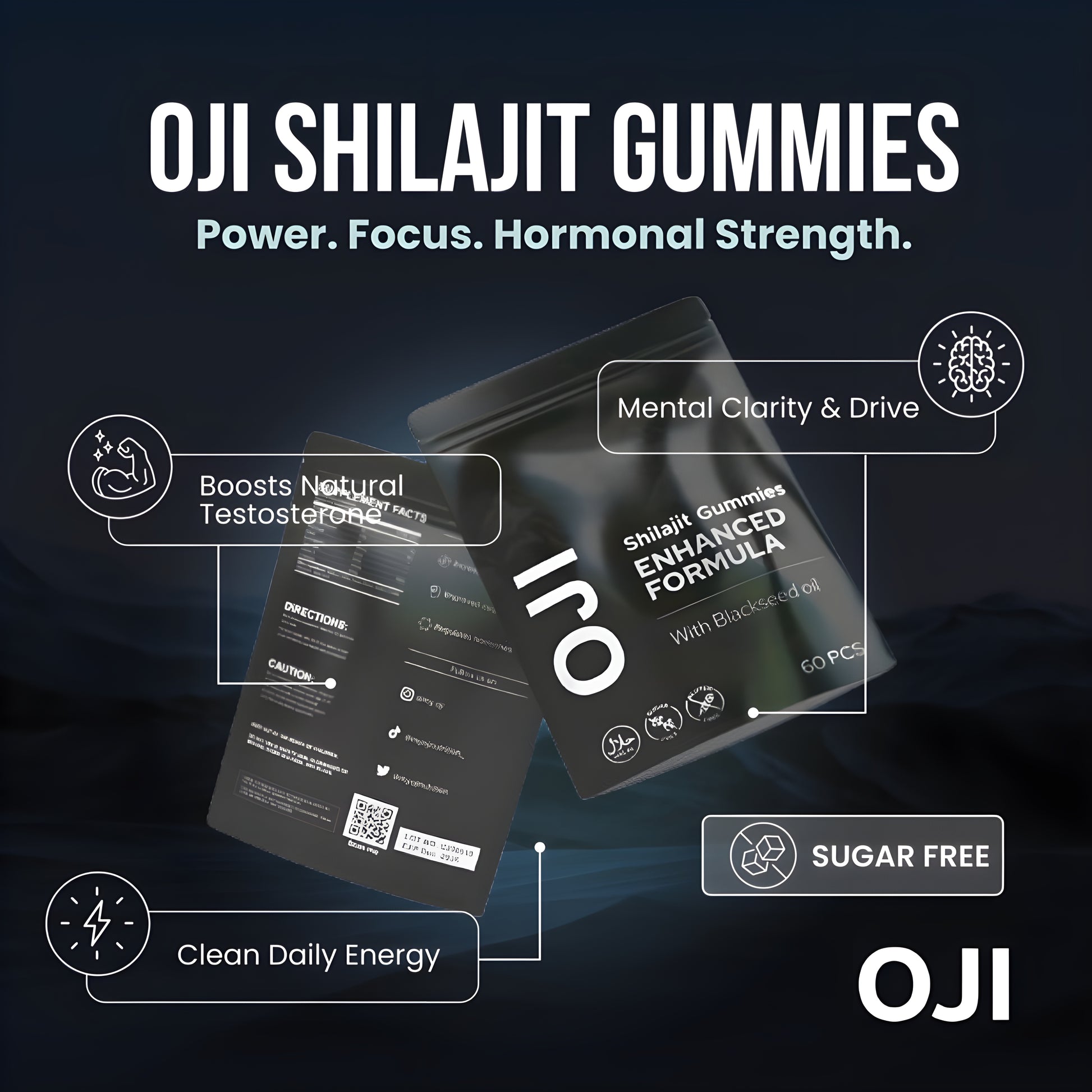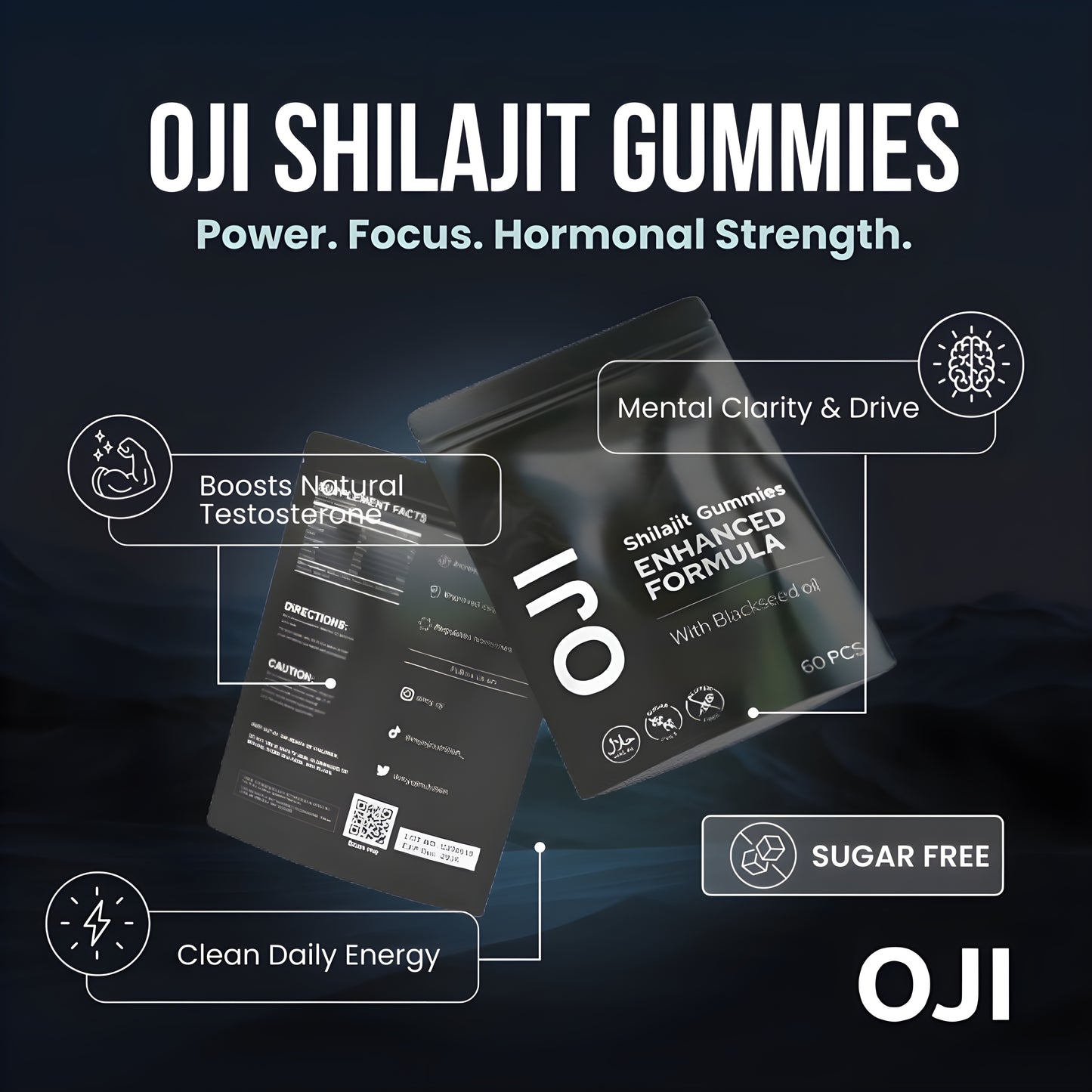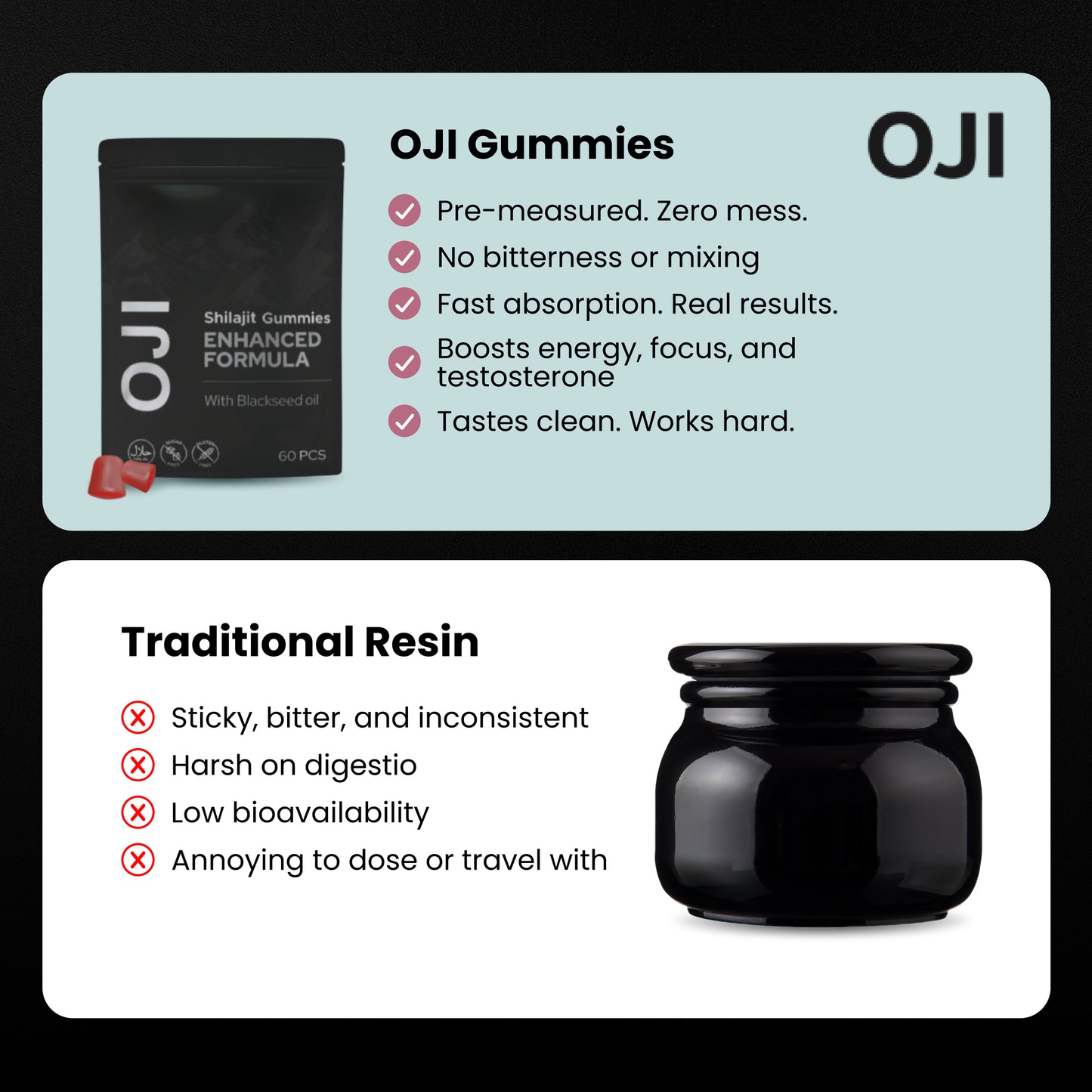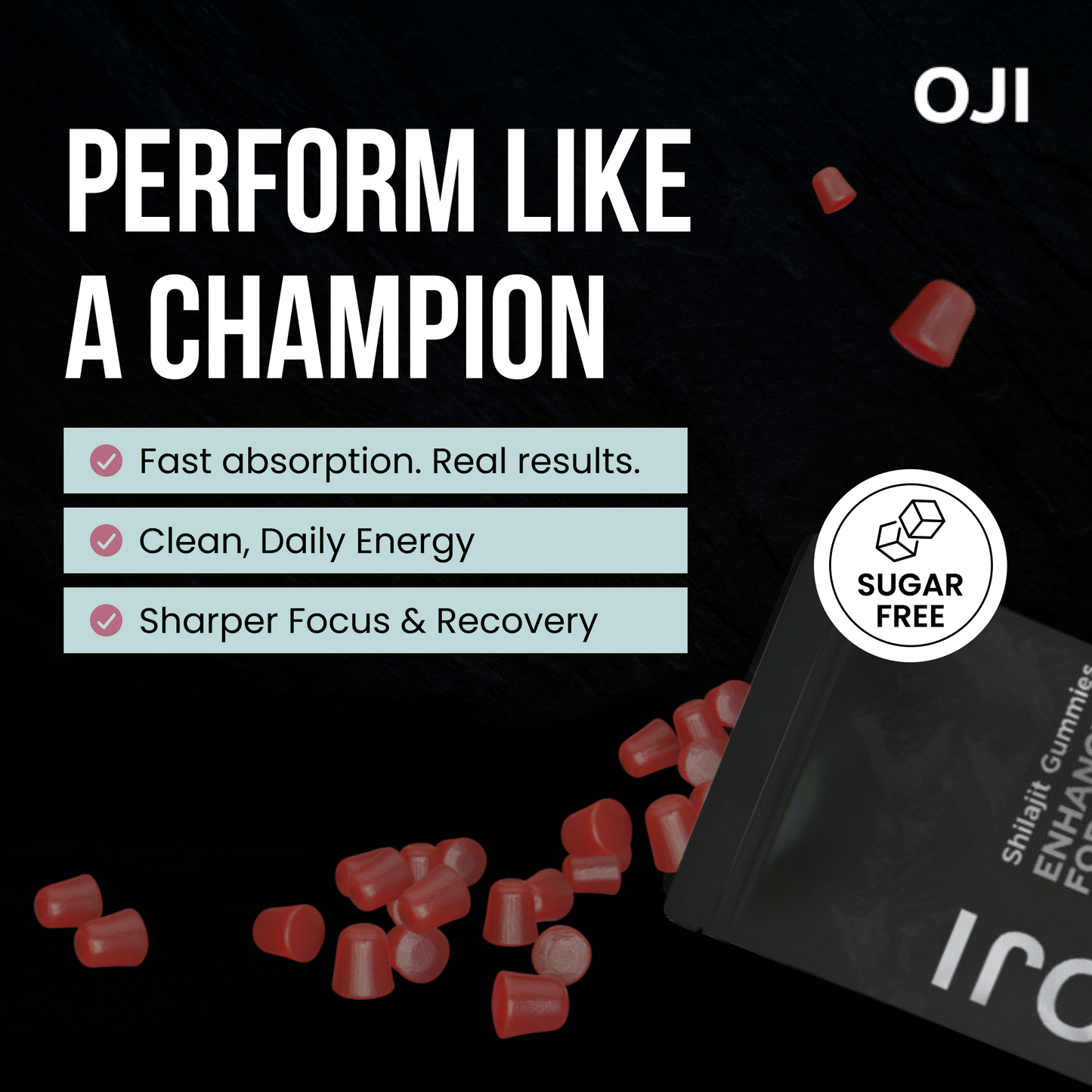Before you can combat chronic fatigue, you first need to understand the reality of it. This guide focuses on the actionable steps you can take, from navigating the UK healthcare system to building a sustainable energy plan. It’s about taking your own experiences and applying evidence-based strategies to start reclaiming your energy.
Understanding the Reality of Chronic Fatigue in the UK

For years, the true scale of chronic fatigue in the UK was massively underestimated, which left thousands of people feeling completely alone and unheard. Thankfully, that’s starting to change. New data is finally painting a clearer—and more urgent—picture, backing up what so many have been saying all along.
This new perspective isn’t just about updating old figures. It’s about truly understanding how many lives are affected. Knowing this is your first step; it gives you the power to advocate for yourself and proves just how vital it is to find strategies that actually work.
The Real Numbers Behind Fatigue
The old estimates for debilitating conditions like Myalgic Encephalomyelitis/Chronic Fatigue Syndrome (ME/CFS) were miles off. Groundbreaking research in 2023, which analysed NHS hospital records from over 62 million people, completely changed our understanding.
The new figures suggest around 404,000 people in England are living with ME/CFS. That’s a massive 62% increase on what was previously thought.
The research also revealed a stark gender gap. With a lifetime prevalence of 0.92% for women and 0.25% for men, women are nearly four times more likely to be diagnosed.
This isn't just a niche issue; it's a major public health concern. If you're struggling, these numbers confirm you are definitely not alone.
Navigating Diagnostic Challenges
Getting an official diagnosis can feel like an uphill battle. The symptoms of chronic fatigue often mirror other health problems, which can lead to a long, frustrating process of elimination. It’s all too common for people to be misdiagnosed or have their symptoms waved away at first.
On top of that, other factors can make the journey even harder:
- Gender Bias: The stats show women are diagnosed more often, but they also report having their symptoms dismissed for much longer before finally getting a diagnosis.
- Ethnic Disparities: Some research suggests that people from minority ethnic backgrounds can face even more barriers when it comes to getting diagnosed and receiving care.
- Symptom Overlap: Fatigue is complicated. Sometimes, its symptoms get mixed up with related issues. For example, looking into the symptoms of adrenal fatigue could give you more clues about how your body is handling stress.
Knowing about these challenges ahead of time is half the battle. It helps you prepare for appointments, keep a clear record of your symptoms, and feel more confident in pushing for the thorough investigation you deserve.
Build a Sustainable Energy Plan with Nutrition

Your journey back from chronic fatigue begins on your plate. Food is the fundamental fuel for our bodies, but when you're already exhausted, the last thing you need is a complicated, restrictive diet plan.
The secret isn’t a massive, stressful overhaul. It's about making small, sustainable tweaks that support your body instead of overwhelming it. Think of your energy like a flickering flame; we want to give it a steady supply of slow-burning fuel, not a quick flash that fizzles out. This is all about balance and nutrient density, not deprivation.
Stabilise Your Blood Sugar for Consistent Energy
Wild swings in blood sugar are a massive culprit behind energy crashes and brain fog. When you reach for refined carbs or sugary snacks on their own, you get a huge spike in blood sugar, followed by an even bigger crash. This leaves you feeling drained, irritable, and craving more of the same stuff.
The solution is to build balanced meals.
By pairing your carbs with protein and healthy fats, you slow down the release of sugar into your bloodstream, creating a much more stable and consistent energy supply. For example, instead of just having toast with jam for breakfast, try a slice of whole-grain toast with creamy avocado and a boiled egg. That little swap makes all the difference.
Here are actionable steps to get you started:
- Add Protein to Every Meal: Include sources like chicken breast, fish (salmon is fantastic), eggs, lentils, chickpeas, tofu, or Greek yoghurt.
- Incorporate Healthy Fats: Add avocado, nuts like almonds and walnuts, seeds (chia and flax are great), and a drizzle of olive oil.
- Choose Complex Carbohydrates: Opt for oats, quinoa, brown rice, sweet potatoes, and whole-grain bread.
Combining these elements at every meal will help you get off that energy rollercoaster. You'll feel fuller for longer and finally ditch those desperate mid-afternoon slumps.
Fuel Your Cellular Powerhouses
Deep down at a microscopic level, your energy is made by tiny powerhouses inside your cells called mitochondria. Chronic fatigue is often tied to these little engines not working as well as they should be. The good news is that certain nutrients are essential for getting them back up and running.
Magnesium, for instance, is a superstar nutrient involved in over 300 processes in the body, including creating ATP – your body's main energy currency. Many people in the UK don't get enough of it. B vitamins are also crucial, acting as the spark plugs in the energy production process.
The key takeaway here is that you can directly support your mitochondria through your diet. Focusing on nutrient-dense foods is a powerful way to rebuild your energy from the cells up.
Take these steps to weave more mitochondrial-supporting foods into your week:
- Boost Magnesium Intake: Eat spinach, almonds, black beans, and even a bit of good-quality dark chocolate.
- Prioritise B Vitamins: Consume salmon, leafy greens, eggs, and legumes.
- Load Up on Antioxidants: Add berries, beetroot, and any brightly coloured vegetables that help protect your mitochondria from damage.
Of course, diet is one piece of the puzzle. For a more complete picture, you can explore comprehensive strategies to increase energy levels naturally to complement your new eating habits.
Reduce Inflammation and Identify Personal Triggers
Chronic, low-grade inflammation is a huge, invisible drain on your energy. Your immune system uses up a massive amount of resources to fight it, leaving very little left for you to go about your day. An anti-inflammatory diet, focused on whole, unprocessed foods, can help calm things down.
This means getting plenty of omega-3 fatty acids, which you'll find in oily fish like salmon and mackerel, as well as in flaxseeds and walnuts. These healthy fats actively work to reduce inflammation in the body. At the same time, try to cut back on pro-inflammatory foods like processed meats, sugary drinks, and refined vegetable oils.
It’s also worth considering that a hidden food sensitivity could be a big, often-missed, reason for your fatigue. Common culprits include gluten, dairy, and soy. If you have a suspicion, keeping a simple food and symptom diary can be really enlightening. You might start to see a clear link between what you eat and how you feel.
For a deeper dive, our guide to natural ways to boost energy offers some extra tips on this.
Master Restorative Sleep and Energy Pacing
If you're battling chronic fatigue, hearing "just get more sleep" is probably the most frustrating advice imaginable. It's rarely about the number of hours you spend in bed. The real problem is the quality of that rest.
Real recovery comes down to two things: making your sleep truly restorative and learning to manage your daily energy. This second part is a technique called pacing, and it’s a total game-changer.
When your nervous system is stuck on high alert, simply closing your eyes won't cut it. Your body needs to feel safe enough to actually switch off and start repairing. This is where mastering your sleep routine becomes non-negotiable.
Cultivate Deeply Restorative Sleep
The mission is to create a sleep environment that sends a powerful "all clear" signal to your brain. This goes way beyond just turning off the lights. It's about building a consistent, calming routine that your body begins to crave.
You can't expect to go from 100 mph to a dead stop. Your body needs a gentle off-ramp. Aim for a 30-60 minute wind-down period before you even think about getting into bed.
- Dim the Lights: An hour before bed, start lowering the lights. This simple act helps kickstart the production of melatonin, your body’s natural sleep hormone.
- Disconnect from Screens: The blue light from your phone is a melatonin killer. Put it away and pick up a book or listen to some quiet music instead.
- Create a Sanctuary: Your bedroom needs to be cool, dark, and quiet. Blackout curtains or a white noise machine can make a world of difference.
Of course, the foundation of good sleep is a good mattress. It's worth comparing spring mattress vs. foam mattress types to find what truly supports your body and comfort needs. And if you need a little extra help, exploring specific supplements for better sleep can offer targeted support to help calm your system for deeper rest.
Understanding the Art of Pacing
Pacing is, without a doubt, the most important skill you can learn to fight back against chronic fatigue. It’s the simple practice of living within your "energy envelope"—the finite amount of mental and physical energy you have each day.
The golden rule? Stop before you feel tired. Don't push through until you hit a wall.
This is how you break the devastating "push-crash" cycle, where you feel okay, overdo it, and then spend the next three days recovering. Pacing isn't about giving up; it’s about smart energy management that leads to more consistency and, over time, a slow and steady increase in what you can handle.
Pacing is proactive, not reactive. You schedule rest before you need it, treating it as an essential part of your day, just like eating or sleeping. It’s a deliberate strategy to conserve energy for what matters most.
The first step is figuring out your baseline. For one week, keep a simple diary of your activities and how you feel. The goal isn't to judge yourself, but to see which tasks drain you the most and what your realistic limits are right now.
Practical Pacing in Your Daily Life
Once you have a rough idea of your energy budget, you can start making small, practical adjustments. The key is to break everything down into smaller chunks with built-in rest periods.
Instead of cleaning the whole house at once, just do one room, then rest for 30 minutes. Instead of a single 30-minute walk, try three 10-minute walks throughout the day. This stops you from draining your battery all in one go.
This infographic lays out the absolute basics for supporting your energy levels. Without these in place, everything else is an uphill battle.
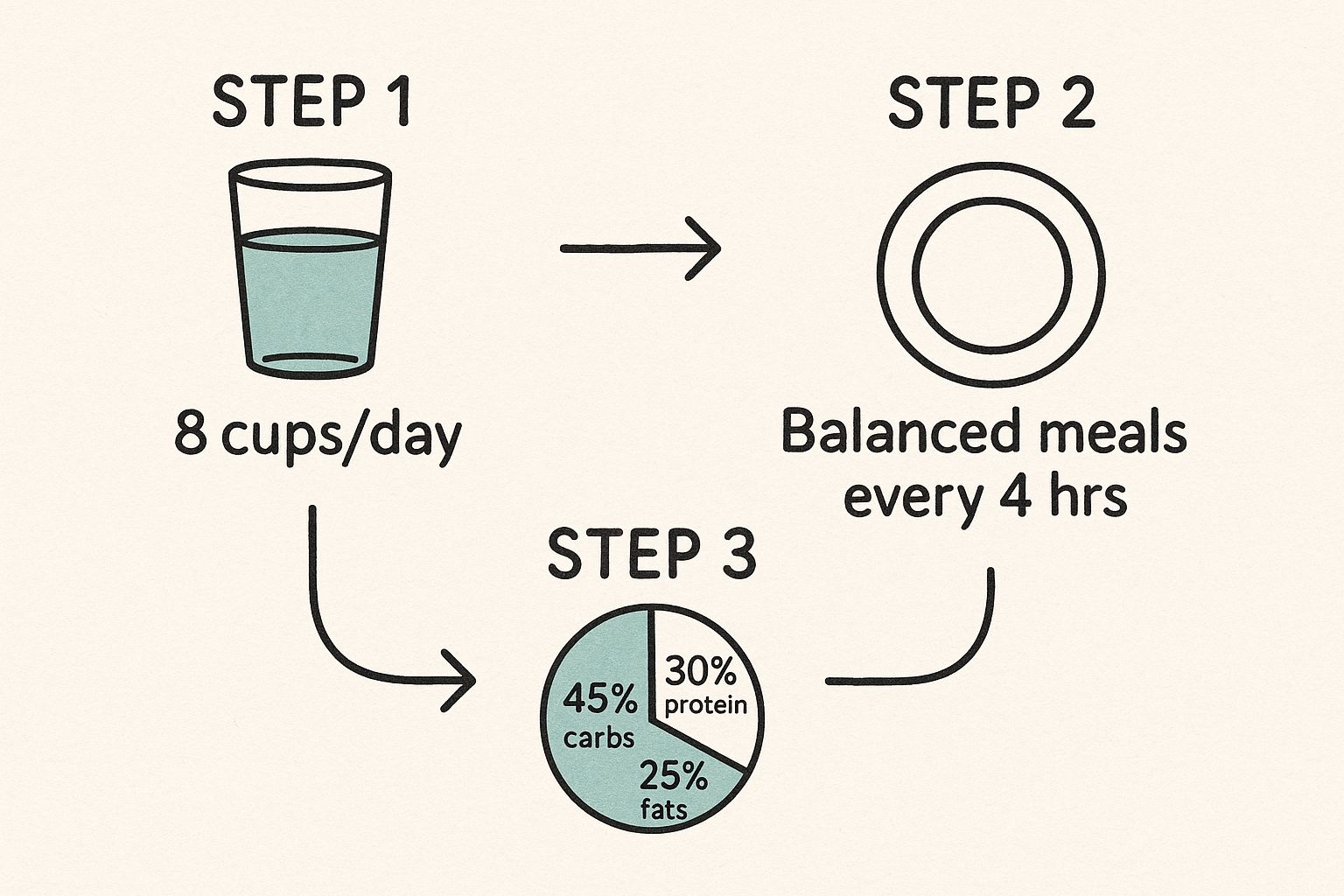
It’s a great reminder that consistent fuel and hydration are the non-negotiable pillars of energy management.
Let's look at how to apply this to common tasks that can feel impossible. The table below shows how you can rethink your approach to conserve energy.
Simple 'Pacing' Adjustments for Daily Tasks
| Common Task | High-Energy Approach (The 'Push') | Pacing-Friendly Approach (The 'Manage') |
|---|---|---|
| Weekly Food Shop | Go to a huge supermarket on a Saturday, walk every aisle, carry heavy bags, and unpack everything at once. | Order heavy items online. Go to a small local shop for fresh bits during a quiet time. Rest for 15 mins before unpacking. |
| Cleaning the Bathroom | Scrubbing the shower, toilet, sink, and floor all in one go, feeling exhausted afterwards. | Clean the toilet and sink one day. Do the shower the next. Mop the floor on a separate day. Break it down. |
| Socialising | Agreeing to a long dinner out, knowing you'll be drained by conversation and travel. | Suggest a coffee for just one hour instead. Have a friend visit you at home so you can rest immediately after. |
| Working from Home | Sitting at your desk for 4 hours straight, pushing through a brain fog to meet a deadline. | Work for 45 minutes, then take a 15-minute break away from the screen. Break large projects into smaller daily goals. |
As you can see, the "Manage" approach might seem slower, but it allows you to get things done without triggering a massive energy crash.
It's all about working smarter, not harder. By consistently applying these pacing principles, you start to build a more stable foundation of energy, giving your body the space it finally needs to heal.
Calm Your Nervous System to Restore Energy
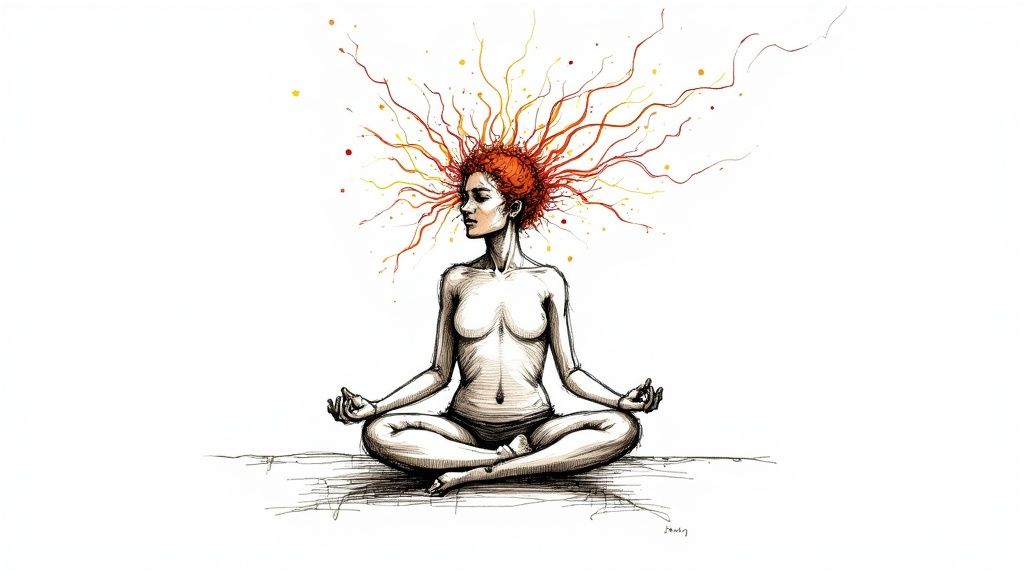
If you're dealing with chronic fatigue, you probably feel like your body is permanently stuck in overdrive. It’s as if your internal alarm system—the sympathetic nervous system—is blaring all day long. This "fight or flight" response is a colossal energy thief, leaving you with absolutely no resources left for resting, repairing, or even digesting your food properly.
To really begin to heal, you have to learn how to consciously flip that switch off. The aim is to activate the parasympathetic nervous system, what we call the "rest and digest" state. This is where the magic happens, where your body can finally start to recover. And the good news is, it's a skill you can develop, even when you feel completely wiped out.
Think of the following techniques as your personal toolkit for finding calm. They're all simple, don't require much energy, and are designed to dial down the physiological stress that keeps you exhausted.
Master the Power of Your Breath
The quickest way to directly influence your nervous system is through your breath. When we're stressed and tired, our breathing tends to get shallow and fast, which just reinforces the danger signals being sent to our brain. Diaphragmatic breathing, or simple "belly breathing," can completely reverse this.
It works by stimulating the vagus nerve, a major player in your parasympathetic system. Activating this nerve sends a powerful "all clear" signal throughout your body, helping to slow your heart rate and release built-up tension.
Follow these steps anywhere, even lying down:
- Place one hand on your chest and the other on your stomach.
- Breathe in slowly through your nose for a count of four. Feel your stomach rise while your chest stays relatively still.
- Hold your breath for just a second.
- Breathe out slowly through your mouth for a count of six, feeling your stomach fall.
Just a couple of minutes of this can make a world of difference. It's a profound but incredibly simple way to take back a bit of control from your body's stress response.
Tune Into Your Body with Gentle Awareness
When fatigue hits hard, it’s easy to feel totally disconnected from your own body. A body scan meditation is a fantastic way to gently check back in without needing to move a muscle. All it involves is bringing a curious, non-judgemental awareness to different parts of your body, one by one.
You’re not trying to fix or change anything here; you're just noticing. What do you feel? Warmth, tingling, tightness, or maybe nothing at all? The act of observing pulls you out of those exhausting, looping thoughts and grounds you in the present moment, which is a huge relief for a frazzled nervous system.
By simply noticing what's going on in your body without judging it, you're teaching your nervous system that it's safe to power down. You're shifting from a state of high alert to one of gentle presence, which is vital for recovery.
You can find hundreds of free guided body scans online, and many are only 10-15 minutes long. It's the perfect practice for when you're too tired for anything else but desperately need a moment of peace.
Embrace Mindful and Gentle Movement
For anyone trying to overcome chronic fatigue, the very idea of "movement" can be terrifying, especially with the risk of triggering a crash. The trick is to completely redefine what movement means. It doesn’t have to be a workout. It can just be a gentle, restorative practice.
Mindful movement is all about the mind-body connection. The focus is on finding calm, not on intensity. It’s about moving in a way that soothes your nervous system instead of revving it up.
Here are a few ultra-gentle ideas to consider:
- Restorative Yoga: This style involves holding deeply relaxing poses, fully supported by pillows and blankets, for several minutes. It takes almost zero muscular effort and is specifically designed to trigger deep relaxation.
- A Slow Walk in Nature: If you have the energy, even a five-minute stroll outside can be incredibly powerful. Try to focus on the feeling of your feet on the path and the sights and sounds of nature around you. The mix of gentle movement and a natural setting is a proven calming combination.
The golden rule is this: always finish feeling better and more relaxed than when you started. If an activity makes you feel more tired, it was too much for today. Learning to listen to these cues is a massive part of calming your system and slowly, gently rebuilding your energy.
Using Supplements for a Targeted Energy Boost
While getting your nutrition, sleep, and stress levels sorted are the absolute cornerstones of recovery, the right supplements can offer incredibly valuable, targeted support.
Think of them less as a magic bullet and more as strategic allies. They’re there to help fill in any nutritional gaps and give your body’s own energy-producing systems a helping hand.
The world of supplements can feel like a minefield, though. It’s so easy to get overwhelmed. The key is to have a clear strategy and focus on what your body is actually crying out for, not just chasing the latest trend. And, of course, always have a chat with your GP or a qualified health pro before starting anything new.
First Things First: Are You Running on Empty?
So many people battling fatigue are, without even realising it, low on the very vitamins and minerals their bodies need to create energy at a cellular level. Pinpointing and fixing these deficiencies—with professional guidance—can be a massive leap forward.
There are a few usual suspects when it comes to fatigue:
- Magnesium: This powerhouse mineral is involved in over 300 different processes in your body, including making ATP, which is basically your body's main energy currency. If you’re low, your energy levels will feel it directly.
- B Vitamins: The whole B-complex family, but especially B12 and folate (B9), are like the spark plugs for your cellular engines. They are absolutely critical for your mitochondria to produce energy.
- Vitamin D: We often call it the "sunshine vitamin," and for good reason. Levels are notoriously low here in the UK, and there’s a strong link between a deficiency and feeling fatigued and down.
- Iron (Ferritin): Iron is essential for making haemoglobin, the stuff that carries oxygen around your body. When your iron stores are low (which a ferritin test will show), your cells just aren't getting enough oxygen. The result? Total exhaustion.
The best way to know for sure is to ask your GP for a blood test. It takes the guesswork out of the equation and lets you supplement precisely what you need.
Getting Smart with Adaptogens
Beyond the basic vitamins and minerals, there's a fantastic class of botanicals known as adaptogens. These don't just give you a raw energy kick; they actually help your body become more resilient to both physical and mental stress.
This is a game-changer because, let's face it, the journey to getting a diagnosis for fatigue can be incredibly long and stressful. For conditions like ME/CFS, the lack of a simple test means many people, particularly from underrepresented groups, suffer without recognition. In fact, the latest UK estimates suggest around 0.6% of the population, or roughly 404,000 people, are affected—and that figure is just based on NHS records for 'post-viral fatigue syndrome', the closest available proxy. You can read more about the prevalence estimates for ME/CFS in the UK to see the sheer scale of the issue.
Adaptogens work by helping to balance your body's response to these ongoing stressors, whether they're physical or emotional. This conserves precious energy that would otherwise be wasted on keeping you in a state of high alert.
What’s the Deal with Shilajit?
One unique substance that's really getting noticed for its fatigue-fighting potential is Shilajit. Found high up in mountain ranges, this natural resin is a powerhouse of nutrients, formed over centuries from decomposing plants.
What makes Shilajit so special is its incredible concentration of fulvic acid and more than 85 different trace minerals. Fulvic acid is thought to act like a delivery truck, helping to shuttle all those essential minerals directly into your cells where they're needed most.
Its main superpower lies in supporting your mitochondria—the tiny powerhouses inside your cells that generate nearly all your energy. Research suggests that the compounds in Shilajit can help protect these mitochondria from damage and make them more efficient at producing ATP. For anyone whose cellular energy is already compromised, that kind of targeted support is huge.
When you look at a product like Oji Shilajit, you’re getting this ancient remedy in a modern, easy-to-take form. It's often combined with other brilliant adaptogens like Ashwagandha to double down on stress resilience and energy. It’s a multi-faceted approach, tackling both the energy deficit at a cellular level and the body’s overworked stress response at the same time.
Got Questions? Let's Talk It Through
As you start putting all this into practice, it’s completely normal for questions to come up. Figuring out what works for you is all part of the process, and having clear answers can help you stay on track.
Here are a few of the most common things people ask when they start tackling chronic fatigue.
How Long Until I Start Feeling Better?
This is usually the first question on everyone's mind, and the honest answer is: it’s different for everyone. Your recovery journey is uniquely yours.
Some people notice small, welcome shifts in their energy within a few weeks, especially after getting their nutrition and sleep sorted. For others, particularly those dealing with long-term conditions like ME/CFS, it can be a much slower burn, unfolding over months or even years.
The trick is to stop looking for a quick fix and start celebrating the small wins. Maybe you had one slightly better day this week. Maybe you recovered from a short walk a little faster than usual. Recognising that gradual, steady progress is still progress is key.
Exercise: Friend or Foe?
This is a big one, and it needs to be handled with care. For general, everyday tiredness, some gentle exercise can definitely be a good thing.
But—and this is a big but—if you experience post-exertional malaise (PEM), it’s a different story. PEM is a hallmark of ME/CFS, where any kind of exertion leads to a massive crash in your symptoms. In this case, the wrong kind of exercise can do real harm.
It's so important to know that Graded Exercise Therapy (GET), an old-school approach of constantly pushing your activity levels, is no longer recommended by NICE for ME/CFS. It has the potential to cause serious relapses.
The golden rule is pacing. Start incredibly small. Think a few minutes of light stretching or a very slow stroll to the end of the garden path. Then, you absolutely have to monitor how you feel for the next 24-48 hours. If your symptoms flare up, you’ve overdone it. It’s always best to chat with a knowledgeable doctor or health professional before you try any new movement routine.
Should I Bother with Nutrient Deficiency Tests?
Yes, one hundred percent. Asking your GP for some blood tests, or working with a registered nutritional therapist, is one of the smartest moves you can make.
So many common nutrient deficiencies are tied directly to fatigue. The main culprits include low levels of:
- Iron (ferritin): You need it to get oxygen to your cells.
- Vitamin B12: Absolutely essential for producing energy.
- Vitamin D: There’s a strong link between low levels and fatigue.
- Magnesium: It’s involved in hundreds of reactions that create energy in your body.
A simple test can pinpoint exactly what’s missing, which means you can supplement intelligently instead of just guessing. Taking high doses of supplements without knowing your baseline levels is a shot in the dark. Get the data first.
At Oji, we’re all about providing natural, targeted support for your energy and resilience. Our Shilajit gummies are made to help replenish those essential minerals that support your body’s vitality.
Discover how Oji Shilajit can support your energy journey today.


